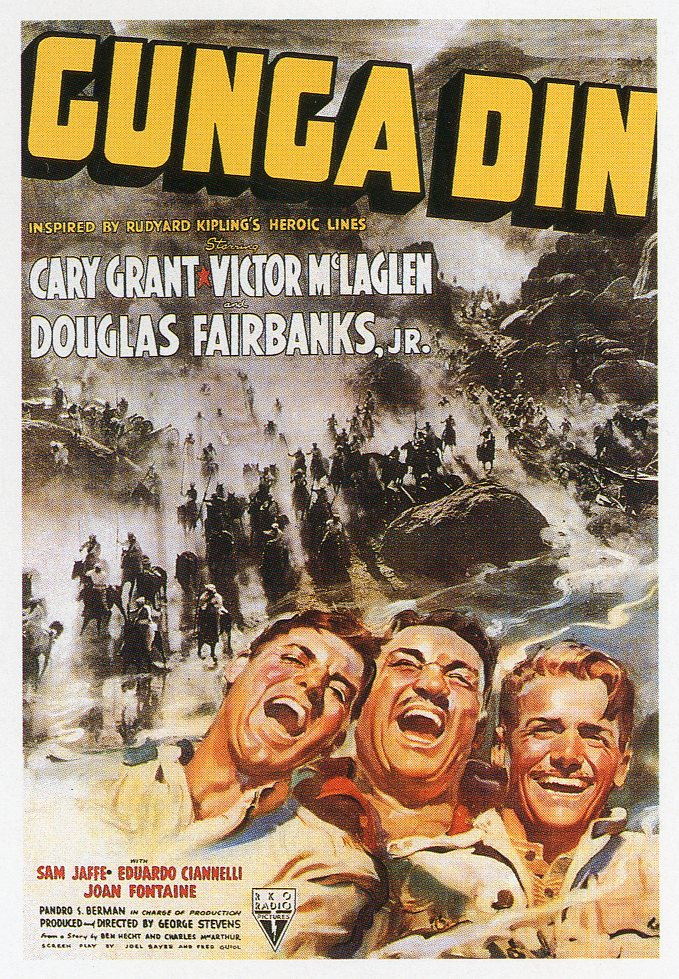Our seventeenth classic possibility for 2014 is 75 years old this year, the popular action-adventure Gunga Din (1939). It was produced by RKO Radio Pictures at a colossal cost of almost two million dollars but the money is evident on the screen and it was a big hit. Almost any other year and it would be a bona fide Oscar contender — but this was 1939, a year when every studio was cranking out hits both popular and acclaimed. Despite ten slots for Best Picture, RKO snagged only one, for Love Affair. Yet it is Gunga Din which has remained more firmly in the public consciousness — mainly because its eponymous hero was made famous by Rudyard Kipling long before the movie was made. The finished film bears little resemblance to Kipling’s five-stanza ode to an Indian water-carrier, although it seems faithful in spirit, and it does allow the ever-enthusiastic Gunga Din (Sam Jaffe) to save an entire regiment, not just the one soldier wounded in the poem. To reinforce the connection between verse and film the journalist Kipling (Reginald Sheffield) is present to accompany the British regiment on their fateful march through the desert, he composes the poem after the battle, and Colonel Weed (Montagu Love) even reads the last few lines at the film’s conclusion. And it is said that the characters of the three sergeants in the film are based on the three privates Otheris, Mulvaney and Learoyd in Kipling’s “Soldiers Three” short stories.
What we witness in the film is a trio of hearty adventurers. The romantic one is Ballantine (Douglas Fairbanks, Jr. — although Cary Grant was originally cast in that role). Handsome and fair-haired, Fairbanks Jr. is the perfect choice for a romantic lead — except that Ballantine’s loyalty to his friends is unshakable, even for the likes of beautiful Emmy (Joan Fontaine). What exactly this frilly lass is doing in the Indian desert with a regiment of British soldiers is never satisfactorily explained, at least to me, but never mind. Emmy has lassoed Ballantine and she means to keep him, even if she does suspect that his friends deplore his choice (even as they envy him).
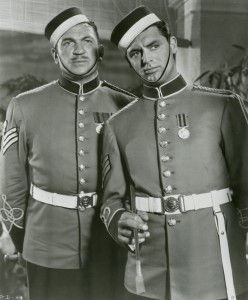
The rugged one, the real leader of the trio, is MacChesney (Victor McLaglen), a veteran, no-nonsense soldier who enjoys having the younger ones around to handle the more physical stuff. MacChesney’s true joy is the elephant Annie, whom he feeds by hand. When she feels poorly, so does he, opting to sleep nearby to make her feel better. And the carefree one is Cutter (Cary Grant; this is the role he really wanted). Cutter is a free spirit who loves his comrades, but he also entertains ideas of getting rich in this strange land and returning to England with enough gold to buy a pub and settle down properly. It is made plain very quickly in the story that these three men form an ideal triumvirate — like a British version of the Three Musketeers — complementing one another in every way. But two situations emerge which threaten their friendship: Ballantine’s impending nuptials with Emmy, and an uprising of a cult thought dead and gone, called the Thuggees (pronounced Tugs). Colonel Weed remembers, or at least knows about, the Kali worshippers who were stamped out some fifty years previously. Weed finds it difficult to believe that the same practice has begun again, but whole traveling parties have been strangled en masse, communications are cut, and one of his units is not reporting.
The Thuggees’ aim is to rob and destroy non-native travelers and interlopers in the name of Kali, the goddess of blood. They strangle their victims, or use a special burial pick to kill them, after digging their graves before an attack is made. It is a religious cult, in this case revived and rejuvenated by Guru (Eduardo Ciannelli, in a fierce performance), whose father was hanged during the last uprising fifty years earlier. “Kill for the love of killing; Kill for the love of Kali; Kill! Kill! Kill!” Guru exhorts his followers. Sounds kind of like ISIS now, to my ears.
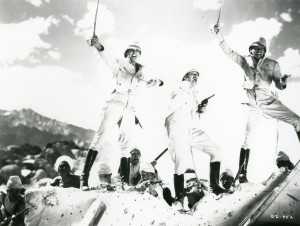
The film boasts two major action sequences. The first is in Tantrapur, where the Thuggees have eliminated the British soldiers there, and are in hiding, waiting for others to arrive. That sequence, which begins rather quietly, eventually builds to a rout in which the sergeants are forced to jump off a cliff into a river to get away with their lives.
The second sequence is in the hills next to the Kali temple, where Guru and his followers await the entire British and Scottish regiments, which they are prepared to ambush. This is a truly large-scale battle, with hundreds, if not thousands, of extras in costume, many on horseback and on or accompanied by elephant, marching and then fighting their way toward the guarded temple to rescue their captured comrades. Long before computers allowed savvy filmmakers to create and inhabit worlds on their desktops, this is the way that epics were made: with the able effort of many, at the discretion of the weather and with a lot of planning.
It is here, at the top of the temple, above the golden sculpture that drives Cutter to distraction, that Gunga Din (pronounced Dean!) ignores the mortal wound to his back, climbs to the very pinnacle and blows his bugle as loudly as he can to sound the alarm. It is among the most heroic of moments ever put on film, all the more so because his friend Cutter has encouraged him to behave like a soldier when no one else wished him to, and because Cutter is close by and cannot do it himself because of his wound. “The Colonel’s got to know!” is Din’s final line, and it echoes one spoken by Cutter when they were trapped in the Kali temple earlier.
Gunga Din’s honorable, heroic death and the rout of the Thuggees might have been a satisfying conclusion, yet it was felt that more needed to be said. Thus, a coda of sorts follows the battle, as Colonel Weed compliments the three sergeants (Cutter has survived and is resting uncomfortably), accepts Ballantine’s re-enlistment paper, then takes up the matter of Gunga Din. “And here’s a man of whom the regiment will always be proud,” says Weed, looking at the body of the dead hero. “According to regulations, he had no actual status as a soldier. But those of us who had the privilege of serving with him today know that if ever a man deserved the name and rank of soldier, it was he. So I’m going to appoint him a corporal in this regiment. His name will be written on the rolls of our honored dead.” And with Rudyard Kipling by his side, the colonel reads the final lines of the newly written poem. “Though I belted him and flayed him, by the living God that made him, you’re a better man than I am, Gunga Din.”
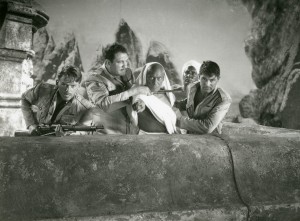
Though this is a rollicking adventure with many comic moments, starring a trio of top-notch British actors, it’s reason for being is the diminutive, dark-skinned, perpetually optimistic water carrier, Gunga Din. Director George Stevens takes the time after the final battle to memorialize and honor Gunga Din. Sure, his is the name of the movie, but how many moviegoers attended to see then 47-year-old Jewish actor Sam Jaffe portray an Indian water carrier? They attended to see dashing Cary Grant and handsome Douglas Fairbanks, Jr. and some cool, epic battle scenes. But Stevens ensured that those audiences left with admiration and respect for a character who was not white, not dashing or handsome, and not one’s typical matinee idol fodder. Gunga Din is the very rare Hollywood blockbuster of the Golden Age that entrusts its heart and soul to such a non-traditional personage. The only characteristic that could have been more of a stretch would have been to make Gunga Din a woman.
The story could not have supported that, of course; Kipling’s poem was well known at the time, and audiences certainly had the expectation of seeing the hero about which they had read. But seeing a story come to life is something else again. Every time I see this movie I am genuinely touched not only by Din’s heroism, but by the honor and respect given to him by those he left behind, to be witnessed by everyone who watches the film. This movie memorializes humanity and decency and brotherhood, and I am a better person for having seen it; I hope this applies to others as well.
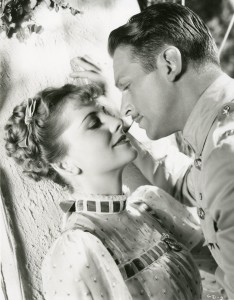
Other rewards exist as well. I don’t think much of the film’s romantic moments, mainly because they are undercut by MacChesney’s and Cutter’s disdain — although each of them would like to be in Ballantine’s shoes. What does work is its comedy. I absolutely love the scene where Gunga Din brings back a “big tool” to help Cutter escape the brig. That tool is Annie the elephant, and within moments the small jail is destroyed by the persnickety pachyderm — with Cutter still inside. It’s a great scene, especially the first time seen.
The other aspect I really like is the keenness of Stevens’ cinematic touches. Plenty of long shots are utilized to convey the scope of the country, the number of extras, the direction of the battles. Selectively, however, Stevens will cut in stark closeups which reinforce the mood of the moment. Sometimes it’s the evil face of Guru, about to show the sergeants how he will crush the British and Scottish armies. Sometimes it’s one of the sergeants, reacting to something. Because they are used sparingly, those closeups are powerful when they appear. And, of course, the whole thing was filmed in the Lone Pine area of California. The featurette that accompanies the movie on DVD explains that some Indian guides swear they have been to where the film was shot on location — though they have never left India.
Comedy, adventure, inspiration, this movie has it all. It touches upon India’s caste system without trumpeting British colonial rule or condemning the native population for not ruling themselves. It’s an adventure first and foremost, but takes seriously the situation, the characters and the origins of its story. By including the writer Kipling (although he was edited out of re-releases because the Kipling family had objections to his inclusion) the film acknowledges the history of the story and provides a clean, clear connection that links everything together.
Is Gunga Din a classic? Absolutely! It is beautifully filmed, spectacularly staged and contains one of the finest conclusions in American film history. Fans of Joan Fontaine may be disappointed but everyone else should find plenty to celebrate in this time-honored classic. Astonishingly to me, the only Academy Award nomination it earned was for Black and White Cinematography, which it lost (to Wuthering Heights), but 1939, as mentioned previously, was a year in which every studio made something great. In other years this movie could have been a Best Picture winner; in 1939 it didn’t even earn that nomination. It doesn’t matter; time has not dimmed its aura, nor its popularity. It’s a little weird (perhaps unfortunate is a better word) to see Sam Jaffe portray an Indian, but he did a great job. The fact that this movie was made at all, and was bold enough to memorialize such an untypical character as a hero, is evidence enough that even then, Hollywood filmmakers could take positive stands about humanity. They would need to very soon, with the advent of World War II right around the corner. If anyone needed (or needs) proof that movies can be used for greater good while retaining popular elements of entertainment, this is a prime example. ☆ ☆ ☆ ☆. 6 December 2014.

